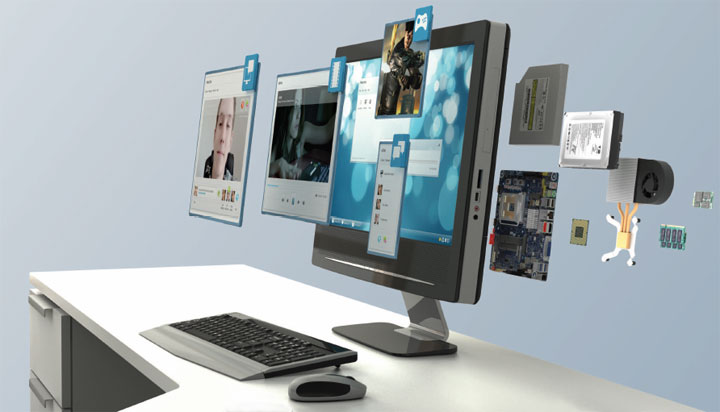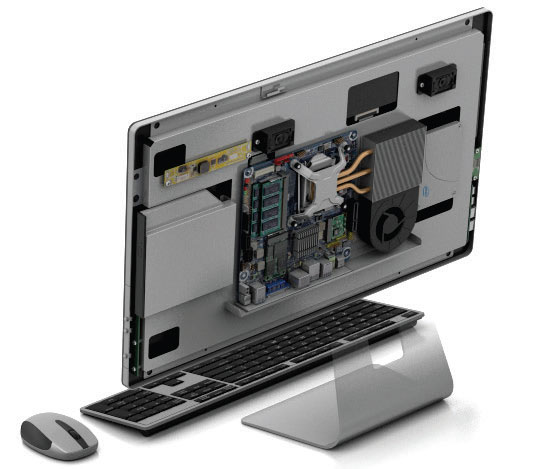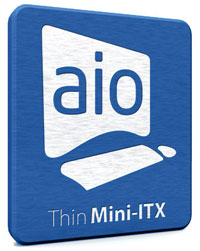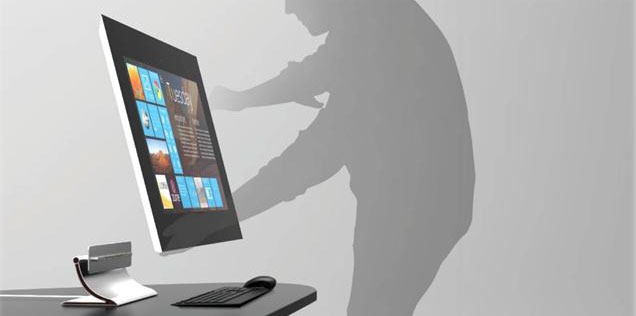All-in-One PC: one for all

Desktop PCs, by the standards of the rapidly changing digital world, belong to the category of dinosaurs: since their appearance in the mid-80s, they have not undergone any fundamental changes. Such mossy causes industry some concern, because you need to make a bet on the correct trend, the correct motion vector - when it starts. Well, or, ideally, to create this vector yourself, defining what should be a modern personal computer. One of the possible and, according to Intel, very promising options, actively promoted right now, is the AIO - All-in-One PC. About him and will be discussed in this post.

AIO, back view with lid open
What is AIO? First of all, it is a miniature PC, made in the form of a monoblock or nettop. It can be considered a further development of the idea of a mini-PC with several specific features.
 The first and main feature is a standard Thin mini-ITX motherboard. This moment is so fundamental that the form factor is even inscribed in the AIO logo. For a long time, it was the incompatibility and the associated difficulties in repairing and upgrading that prevented the ubiquity of mobile PCs. Now, from this point of view, AIO is no different from a regular PC: all components are standard and easily replaceable at home.
The first and main feature is a standard Thin mini-ITX motherboard. This moment is so fundamental that the form factor is even inscribed in the AIO logo. For a long time, it was the incompatibility and the associated difficulties in repairing and upgrading that prevented the ubiquity of mobile PCs. Now, from this point of view, AIO is no different from a regular PC: all components are standard and easily replaceable at home.As the name implies, the Thin mini-ITX form factor differs from the simple mini-ITX in reduced system thickness: the I / O panel width is 25 mm instead of 44 mm, the memory bars are laid flat in the future (Intel patented holders will appear in the near future) 2 slats one above the other). The processor location is also standardized for cooling unification. A promising base for building Thin mini-ITX systems will be the fourth-generation Intel Core processors (Haswell), and now they are selling AIO based on Sandy Bridge and Ivy Bridge. Motherboards are built on the H61 and Z68 chipsets, they are produced by several companies, including, of course, Intel - the DH61AG model.

Thin mini-ITX (right) and mini-ITX motherboards
')
The second feature is the widespread use of wireless interfaces. It would be strange if such a stylish little thing as AIO, overgrown with a beard of wires. For greater clarity, the slogan was put forward: “one computer - one wire”. This refers to the power cable, of course. However, you can do without it, if you add a battery and a wireless charger. This is how experts see the future home computer - stationary and mobile at the same time. You can install it on a stand, connect a mouse and keyboard to it (wireless, of course), or you can expand it as a large tablet for joint leisure and activity. Despite the large display diagonal (24-27 inches), by optimizing power consumption, it is planned to achieve decent AIO autonomy - about 4 hours with a battery weight of not more than 15% of the total mass of the device.
As for the data transfer interfaces, AIO is focused on the future standard “gigabit Wi-Fi” IEEE 802.11ac. In the meantime, in his absence, we will do with 802.11n.

CPU cooling device
Feature three - touch display. Currently, not all marketed AIOs are equipped with a touch screen, but it is this feature that makes this class of devices conceptually complete. The touch control simplifies the system interface to the maximum and makes any control devices unnecessary. In fact, AIO can be considered as a giant tablet and a monoblock computer at the same time. However, user interfaces are not limited to the touchscreen, in particular, it is assumed active use of voice commands. The touch screen itself will be used much more widely than in traditional devices: its duties will include gesture recognition and support for multitouch of several people at the same time.

AIO installation options
The fourth distinguishing feature of AIO is the extensive use of Intel mobility and security technologies. Naturally, a system built on an Intel processor and chipset is able to fully utilize all their functionality. We list the most relevant technologies for this class of devices: these are Smart Response, Rapid Start, Smart Connect, Identity Protection ... for sure, new ones will also be added to this list, including those developed directly for AIO.

AIO architecture
To sum up the above, what functions can AIO perform in a digital home infrastructure? We list the main ones:
- Workplace in its classic sense. Equipped with a keyboard and mouse, the AIO is a “regular” high-performance PC with a large display, suitable for any task.
- Universal media player. AIO is equipped with a sufficient number of analog and digital outputs to work with any kind of multimedia. If you need to display a picture on an even larger display, you can use HDMI. I would not be surprised if Wireless Display support is announced.
- Terminal for video calling. Built-in camera and microphone array make AIO a convenient means of communication; probably this kind of device is best suited for family conferences.
- Entertainment center for the whole family. In the “tablet” mode on AIO, you can draw, play toys, including collective ones, and a lot more - everyone will come up with their own fun.
In general, indeed, All-in-One is obtained. All in one.
Just as AIO will find its application in the professional field. Training computer classes, information terminals and self-service systems, workplaces of doctors and equipment operators - AIO is useful wherever mobility and visibility are required.

He took off - and suffered ...
As in the case of mini servers, I would like to note that AIO is not a concept, but a commercial product that is being actively sold now and demonstrating the highest growth rates on the PC market - 23% per year. According to forecasts, in 2013, 17 million AIO will be sold. No one wants to enter their number?
Source: https://habr.com/ru/post/159781/
All Articles